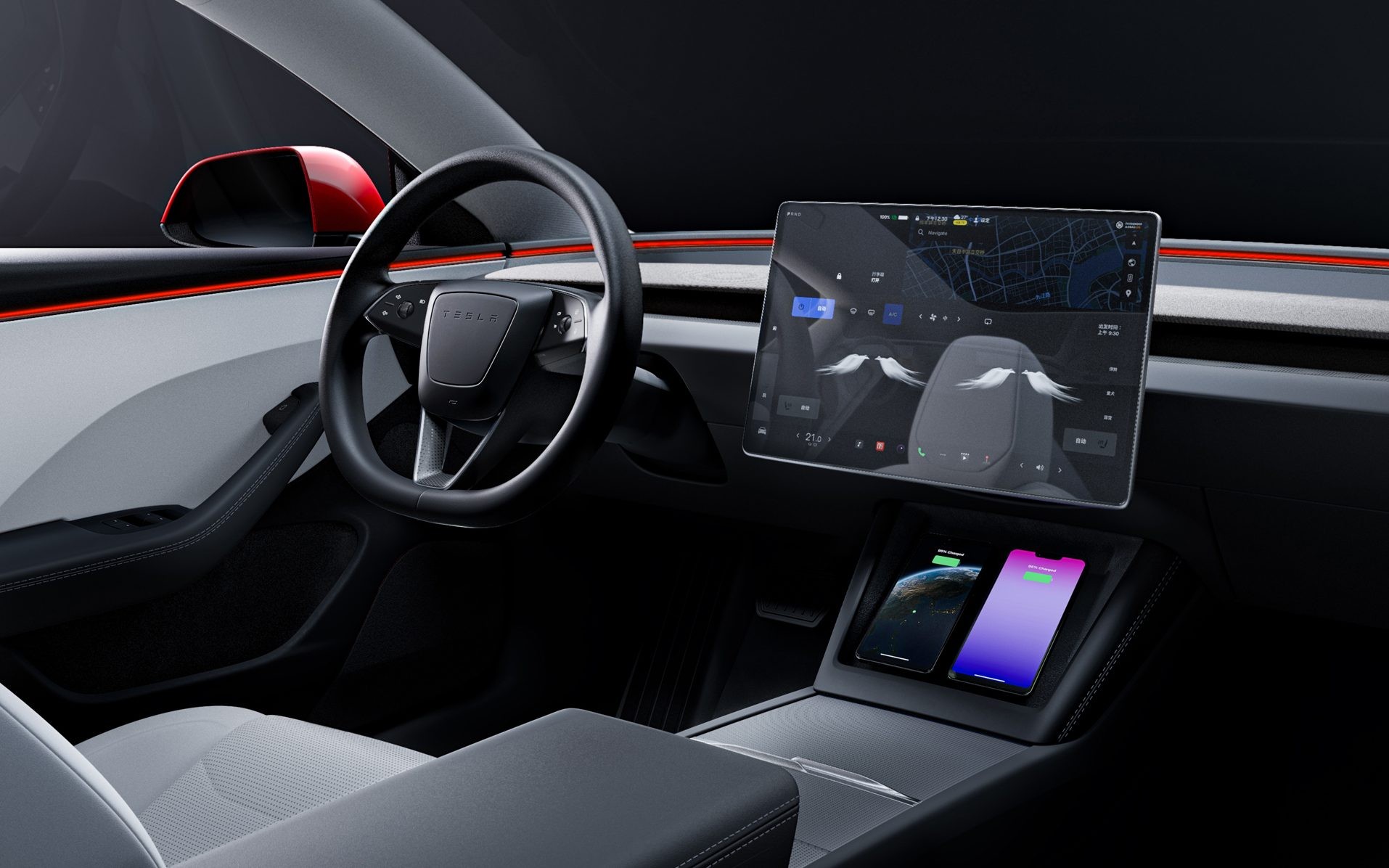The Tesla Model 3 has undeniably shaken up the automotive world, forcing traditional manufacturers to rethink their strategies and accelerate their own electric vehicle (EV) development. For many, owning a Tesla has become a statement, aligning with a tech-forward, future-oriented mindset. However, as the market matures and competition intensifies, particularly from Chinese automakers, does the updated new Tesla Model 3 still hold its crown? After spending time behind the wheel, we delve into the refreshed Model 3 to see if it continues to lead the pack.
The arrival of the updated new Tesla Model 3 sparks excitement, particularly for those already invested in the Tesla ecosystem. This iteration refines the minimalist approach Tesla is known for. The previous Model 3 was notable for its strikingly sparse interior, ditching the conventional instrument cluster in favor of a central touchscreen display. Everything, including speed, was presented on this single screen.
One notable change in the new Tesla Model 3 is the removal of indicator stalks. Following a trend seen in some Ferraris, turn signals are now activated via buttons on the steering wheel.
While this might seem like a step forward in minimalist design, it introduces practical challenges. Indicating at roundabouts, especially when needing to signal a left turn after a right turn with the steering wheel turned, becomes more cumbersome. This design choice might contribute to the sometimes-stereotypical behavior of Tesla drivers and their perceived lack of indicator use.
Wiper controls are also integrated onto the steering wheel in the new Tesla Model 3. A quick press activates a single wipe, a long press initiates screenwash, and a menu on the central touchscreen allows for wiper speed adjustments. While manual adjustment is available through the touchscreen, the automatic wipers were observed to be overly sensitive. The need to access a touchscreen menu for basic functions like wiper speed and mirror adjustments might seem counterintuitive to some drivers.
Despite these control quirks, the absence of a traditional instrument binnacle is not necessarily a drawback. Speed can be easily monitored from the central screen with peripheral vision. However, the lack of a head-up display in a vehicle positioned as premium is a notable omission. Projecting essential driver information onto the windshield would seamlessly solve the issue of glancing at the central screen and enhance driver focus.
The infotainment system in the new Tesla Model 3 has its limitations. Android Auto and Apple CarPlay are not supported. While Bluetooth connectivity is available for calls and native apps like Spotify, Apple Music, and Tidal are integrated, Tesla prioritizes its own in-built media and navigation. Workarounds exist, but they are not officially supported or ideal for seamless integration.
Another minor but arguably unrefined feature is the horn sound upon locking and unlocking the new Tesla Model 3. It emits a simple “toot” rather than a more sophisticated sound expected in a premium vehicle. Interestingly, the “Emissions” app includes playful fart noises, even assignable to the turn signals, a feature that might appeal to children but not necessarily to all adult drivers.
Tesla’s “Autopilot” system, even in its basic form, can be frustrating. While it maintains lane and follows distance, it can disengage unexpectedly when indicating to overtake, failing to recognize intended lane changes. For some drivers, this makes the system less helpful in real-world driving scenarios.
However, despite these criticisms, the new Tesla Model 3 is a significant improvement over its predecessor in many key areas.
Visually, the new Tesla Model 3 is more appealing. The front end has been refined, with cleaner lines and slimmer headlights, moving away from the previous “stubby beetle” appearance. The rear lights are now integrated into the boot lid, resulting in a more cohesive and attractive design overall.
Practical improvements include a redesigned hatch with a gully to prevent rainwater from entering the boot when opened – a surprisingly overlooked detail in the original design, highlighting Tesla’s relative youth as a car manufacturer.
The aerodynamics of the new Tesla Model 3 have been optimized, achieving Tesla’s lowest drag coefficient of 0.219Cd. This contributes to improved efficiency and extended range.
Performance options for the new Tesla Model 3 include the rear-wheel-drive model, achieving 0-60mph in 5.8 seconds, and the dual-motor Long Range version, accelerating to 60mph in a rapid 4.2 seconds. A Performance variant with sub-four-second 0-60 times is also anticipated.
Beyond straight-line speed, the new Tesla Model 3 excels in ride quality and handling. The suspension is well-tuned, providing both comfort for cruising and controlled body movement in corners. The steering is nicely weighted, contributing to a sporty yet approachable driving experience. Road noise is reduced compared to the previous model, although wheel arch noise can still be noticeable in wet conditions.
Tesla’s extensive Supercharger network, with over 12,000 locations in Europe, remains a significant advantage. The new Tesla Model 3 can gain up to 172 miles of range in approximately 15 minutes at a Supercharger, with potential for even faster charging speeds in future upgrades.
Range figures for the new Tesla Model 3 are impressive. The entry-level rear-wheel-drive model boasts an official range of 318 miles, while the Long Range all-wheel-drive version offers a substantial 390 miles. Real-world range is dependent on driving style and environmental factors, but the Model 3 provides comprehensive data menus and accurate range predictions. Tests indicate excellent energy efficiency, achieving over 5 miles per kWh in some conditions.
While competitors are emerging with comparable range and pricing, particularly from Polestar and BYD, Tesla faces increasing pressure, especially regarding pricing strategies. Tesla’s tendency to adjust prices without notice can impact resale values and customer satisfaction. The rise of heavily subsidized Chinese EVs also presents a competitive challenge.
Despite infotainment quirks and playful (or distracting) features, the system in the new Tesla Model 3 is generally responsive and well-organized. Onboard games and entertainment apps, including a buggy racer controllable with the steering wheel and pedals, and a sketchpad app, are popular features, particularly for families.
Rear seat passengers in the new Tesla Model 3 also benefit from a new rear screen for entertainment and climate control adjustments. Streaming services like Netflix, Disney+, Twitch, and YouTube are readily accessible, and Bluetooth headphone connectivity allows for quieter journeys.
Other positives include a responsive mobile app, a minimalist yet customizable cabin with LED strip lighting and interchangeable trim panels, and a conveniently angled phone holder with wireless charging. Comfortable seats, a spacious boot with additional storage, heated rear seats, and multiple USB-C ports further enhance the user experience. The rear seats are positioned low, which might affect comfort for taller passengers.
In conclusion, the new Tesla Model 3 is a significant evolution of an already compelling EV. While some control choices and infotainment quirks might not appeal to everyone, the improvements in styling, range, performance, and technology are undeniable. For Tesla enthusiasts, the new Tesla Model 3 will undoubtedly reinforce their brand loyalty. However, for those considering alternatives, compelling options like the BMW i4, Polestar 2, and Kia EV6 are also worth exploring in the increasingly competitive EV market.

